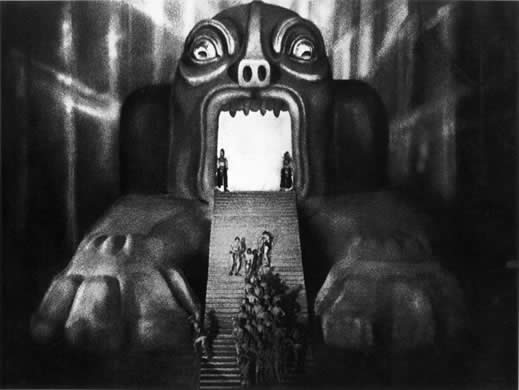Metropolis (1927) was directed by a German man named Fritz Lang but was
written by Lang and his wife, Thea Von Harbou. Metropolis is considered to be
one of the most influential films in regards to special effects and the
boundaries it pushed in film making; considering Metropolis was only made 7
years after Cabinet of Dr. Caligari (1920) you can see how far film making and
the process behind it had come in that short space of time. Whereas previous
films had used a theatrical stage as their set, which gave them limited space
and gave the films a theatre look, Metropolis used bigger sets and bigger
spaces to create a film that looked as if it was set in a real world scenario.
 |
| Fig 1 |
One of the main characteristics to notice in
Metropolis is the use of height in the buildings. ‘The
great city of Metropolis, with its stadiums, skyscrapers and expressways in the
sky, and the subterranean worker's city, where the clock face shows 10 hours to
cram another day into the work week.’ Ebert. This quote,
along with the image above helps to demonstrate and show how Lang used the
infrastructure of the buildings, as if to symbolise the power of industrialism and the insignificance
of the workers and the ‘middle class’ citizens. The buildings used throughout
the film have a sense of Classicism to them in the way they use clean edges and
simplistic designs, but it is used in a way to almost squash the characters and
make them seem so much smaller than they actually are. This also ties in with
the broken will that is portrayed throughout the beginning of the film; since
the storyline is based around social classes and the workers being forced to
work obscene shifts underneath the city, the use of structure ties in with the
themes and motifs well.
 |
| Fig 2 |
The image above
is another way in which Lang used height and structure to convey the power and
the dominance the ‘upper class’ had in comparison to the workers below the
Earth’s surface; the building in figure 2 is the building in which Joh
Fredersen overlooked the city. ‘Metropolis,
the futuristic city, is a barometer for class warfare with the effete rich
enjoying creature comforts high in the sky while the beaten down workers toil
in an underground dystopia of purposeless machines and skull-filled catacombs.’
Brenner, (2011).
Another one of the more famous aspects of
Metropolis was its use of effects throughout the film to create vivid and threatening
mirages that Freder witnessed and became traumatised by.
Figure 3 is a film still from the main machine
featured in the workers area; when the machine blows and workers are injured
and killed, a series of film was played that showed the machine open up and the
workers fall into the pits of the mouth while the other march in unison to
their fate. The use of the buildings and the daunting face on the machine
created a sequence of film that was both disorientating and helped to convey
the message of the film. ‘when the machinery
explodes, Freder has a vision in which the machinery turns into an obscene
devouring monster.’ Ebert.
The use of height in structure is
again evident in the workers underground city, even more so to help show the
dominance that Joh Fredersen had over the city and to carry through the message
of power.
Bibliography
Images
Images
Film Still 1
(Fig 1) http://davidszondy.com/future/city/Metropolis%2001.jpg
Film Still 2
(Fig 2) http://metropolis1927.com/inc/img/gallery/stills/13.jpg
Film Still 3
(Fig 3) http://www.scifiwright.com/wp-content/uploads/2011/01/metropolis01.jpg
Quotes
Robert Ebert. In:
http://www.ebertfest.com [online] At: http://www.ebertfest.com/four/metropolis_silent_rev.htm
(Accessed on 04/10/12)
Paul Brenner. In: http://movies.amctv.com
[online] At: http://movies.amctv.com/movie/1927/Metropolis
(Accessed on 05/10/12)
Robert Ebert. In: http://www.ebertfest.com/ [online] At: http://www.ebertfest.com/four/metropolis_silent_rev.htm
(Accessed on 05/10/12)


No comments:
Post a Comment